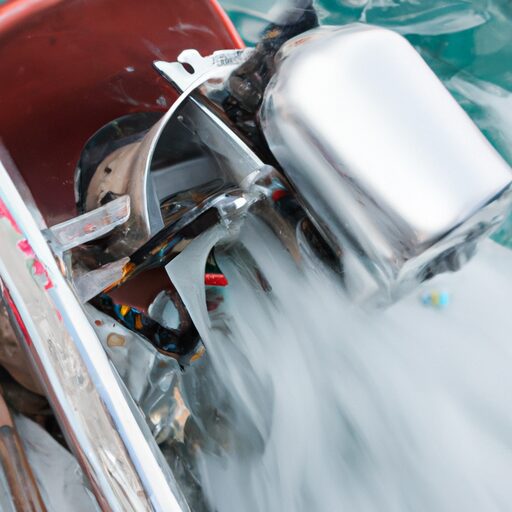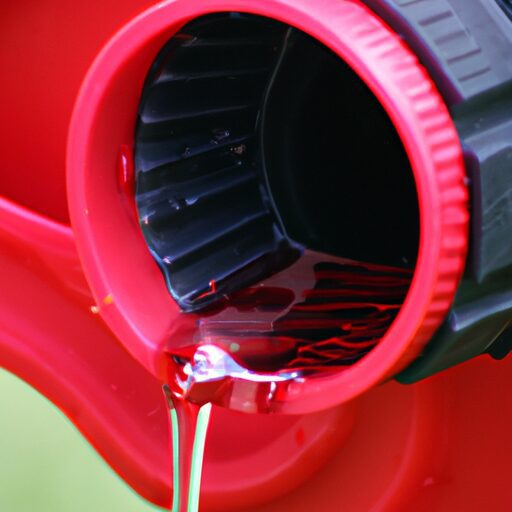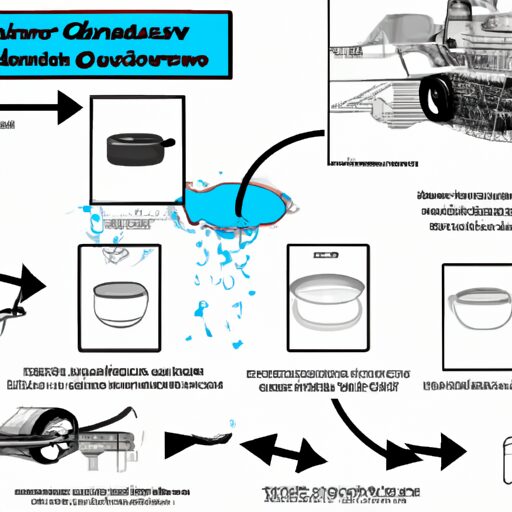Filling Hydraulic Boat Steering Fluid
Hydraulic boat steering fluid plays a crucial role in maintaining the functionality and efficiency of a boat’s steering system. The proper functioning of this system is essential for safe navigation on water bodies. This article provides step-by-step instructions on how to fill hydraulic boat steering fluid, ensuring that readers have a comprehensive understanding of the process.
To begin, it is important to gather the necessary materials and tools required for this task. Locating the hydraulic steering reservoir is then discussed, followed by instructions on removing the fill cap and checking the fluid level. Readers are then guided through adding fluid to the reservoir and potentially bleeding the system if necessary. Finally, testing the steering system and checking for any potential leaks are addressed.
By adhering to these technical instructions, boat owners can effectively maintain their hydraulic boat steering systems, ensuring optimum performance while navigating waterways safely.
Understand the Importance of Hydraulic Boat Steering Fluid
The significance of hydraulic boat steering fluid lies in its ability to maintain proper functioning and control of the boat’s steering system, ensuring safe navigation and maneuverability on water. Hydraulic boat steering fluid is specifically designed to withstand high pressures and extreme operating conditions, making it an essential component for effective steering performance.
One of the benefits of using hydraulic boat steering fluid is that it provides smooth and responsive steering. It helps to reduce friction within the system, allowing for effortless turning and precise control even in challenging situations. This ensures that the captain can easily navigate through tight spots or make quick turns when needed.
Another advantage is that hydraulic boat steering fluid helps to lubricate various components within the system. This reduces wear and tear on critical parts such as the pump, hoses, and cylinders, extending their lifespan and minimizing the risk of mechanical failures.
Furthermore, maintaining proper levels of hydraulic boat steering fluid is crucial for optimal performance. Common signs of low fluid levels include increased resistance while turning the wheel, sluggish response from the helm, or unusual noises during operation. Ignoring these signs can lead to damage to the steering system or loss of control while underway.
To address these issues with low hydraulic boat steering fluid levels, it is important to gather the necessary materials and tools required for topping up or replacing the fluid altogether.
Gather the Necessary Materials and Tools
Gather the essential equipment and materials required for this task. When filling hydraulic boat steering fluid, it is important to have the necessary tools and supplies on hand. Begin by acquiring a container of hydraulic fluid that meets the specifications recommended by the manufacturer of your boat’s steering system. It is crucial to select the right type of hydraulic fluid, as using an incorrect one can lead to malfunctions or damage to the system.
Additionally, ensure you have a funnel with a small opening that fits securely into the reservoir fill hole. This will prevent spills and contamination during the filling process. A clean cloth or rag should also be available to wipe any excess fluid or dirt from surfaces before proceeding.
Before starting, it is beneficial to familiarize yourself with common mistakes when filling hydraulic fluid in order to avoid them. These include overfilling or underfilling the reservoir, using incompatible fluids, and failing to properly bleed air from the system.
Furthermore, consider these tips for choosing the right hydraulic fluid: consult your boat’s manual or contact the manufacturer for specific recommendations, prioritize quality over price, and ensure compatibility with your boat’s steering system components.
With all necessary materials gathered and an understanding of potential pitfalls in mind, proceed to locate the hydraulic steering reservoir in order to continue with the filling process seamlessly.
Locate the Hydraulic Steering Reservoir
To proceed with the process seamlessly, it is essential to locate the reservoir for the hydraulic steering system. The reservoir is typically located near the helm of the boat, where the steering wheel is situated. It may be concealed beneath a cover or accessed through a small hatch. Once you have identified its location, carefully inspect the reservoir for any signs of damage or leaks. Look for cracks, corrosion, or loose fittings that could compromise the integrity of the hydraulic fluid.
To ensure a smooth and safe operation of your boat’s steering system, it is crucial to address any issues with the reservoir promptly. If you notice any damage or leaks, it is recommended to consult a professional technician before proceeding further.
After locating and checking the condition of the reservoir, you can move on to remove the fill cap and check the fluid level in order to maintain optimal performance of your boat’s steering system without interruption.
Remove the Fill Cap and Check the Fluid Level
After locating and inspecting the hydraulic steering reservoir for any damage or leaks, proceed by removing the fill cap to check the level of fluid in order to maintain optimal performance of the system. Checking the fluid level is crucial as it ensures that there is enough hydraulic fluid to lubricate and operate the boat’s steering mechanism effectively. It is important to note that checking the fluid viscosity is also essential, as improper viscosity can lead to poor steering response and potential damage to the system.
To check the fluid level, remove the fill cap located on top of the reservoir. Using a dipstick or a sight gauge, verify that the fluid level falls within the recommended range specified by your boat’s manufacturer. If necessary, add more hydraulic fluid until it reaches the appropriate level.
Additionally, it is essential to adhere to proper fluid disposal guidelines when working with hydraulic boat steering systems. Hydraulic fluids can be harmful if not handled and disposed of correctly. Refer to local regulations or consult with a professional for guidance on how to dispose of used hydraulic fluids safely.
By ensuring proper fluid levels and adhering to correct disposal procedures, you can maintain your boat’s hydraulic steering system’s longevity and functionality. In this section, we will discuss how to add fluid back into the reservoir for optimal performance without interruption.
Add Fluid to the Reservoir
To replenish the reservoir with the necessary liquid, carefully pour the recommended amount of fluid into the designated opening while ensuring it reaches the appropriate level. When adding fluid to the hydraulic boat steering system, there are several important factors to consider:
-
Check Fluid Quality: Before pouring new fluid into the reservoir, inspect its quality. Make sure it is clean and free from any contaminants that could potentially damage the system. If there are any signs of contamination or degradation, it is advisable to replace the entire fluid.
-
Preventing Hydraulic Fluid Leaks: To avoid leaks in the hydraulic boat steering system, it is crucial to use a high-quality fluid that meets manufacturer specifications. Using inferior or incompatible fluids can cause leakage and damage to components. Additionally, ensure that all connections are properly tightened and seals are in good condition.
-
Proper Fluid Amount: It is essential to add the recommended amount of fluid specified by the manufacturer. Adding too little may result in inadequate lubrication and performance issues, while adding too much can increase pressure levels and potentially lead to seal failures.
-
Level Check: After adding fluid, check its level using a dipstick or sight glass provided on the reservoir. Ensure that it falls within the acceptable range indicated by markings on these indicators.
By following these guidelines for checking fluid quality and preventing leaks when filling hydraulic boat steering fluids, you can maintain optimal performance and longevity of your boat’s steering system. Now let’s move on to how to bleed the system if necessary…
Bleed the System if Necessary
If air bubbles are present in the steering system, it may be necessary to bleed the system by releasing the trapped air and allowing fluid to flow smoothly. For example, in a case study of a boat with a hydraulic steering system, the presence of air bubbles caused difficulties in maneuvering the vessel, leading to the need for bleeding the system.
To bleed the hydraulic boat steering system, several steps should be followed. First, locate the bleeder valves on both sides of the hydraulic cylinder. These valves are typically small screws or plugs that can be opened using a wrench or screwdriver. Next, turn the boat’s engine off and rotate the wheel fully from one side to another multiple times to help remove any trapped air. Then, open one of the bleeder valves slowly while having someone else turn the wheel back and forth. This will allow any air bubbles to escape through the valve. Repeat this process for each bleeder valve until all air is removed.
Common problems with hydraulic boat steering systems include spongy or unresponsive steering, excessive noise when turning, and difficulty maintaining a straight course. Bleeding the system can often resolve these issues by ensuring proper fluid flow and eliminating trapped air.
In order to test the steering system and check for leaks after bleeding it, certain procedures must be followed…
Test the Steering System and Check for Leaks
After bleeding the hydraulic boat steering system, it is important to test the system and check for any potential leaks. This step ensures that the system is functioning properly and eliminates any air pockets or blockages that may have been present during the bleeding process.
To test the steering system, start by turning the steering wheel from lock to lock several times. This will help in identifying any unusual noises or resistance in the system. Pay attention to how smoothly the wheel moves and if there are any jerky movements or vibrations.
Next, take the boat out on water and test its maneuverability at different speeds. Ensure that the steering response is immediate and precise. If there are any delays or inconsistencies in turning, further investigation may be required.
During this testing phase, it is crucial to keep an eye out for leaks. Inspect all hydraulic connections and hoses for signs of fluid leakage. Check for wet spots or oil stains around these areas as they can indicate a leak. Additionally, monitor fluid levels regularly to ensure they remain within recommended limits.
By testing the hydraulic boat steering system and checking for leaks, you can troubleshoot common steering issues and ensure a safe boating experience.
Frequently Asked Questions
How often should I check the hydraulic boat steering fluid level?
The checking frequency of the hydraulic boat steering fluid level is dependent on the manufacturer’s recommendations and usage conditions. Regular maintenance tips include inspecting for leaks, ensuring proper fluid levels, and addressing any abnormalities promptly to avoid potential steering issues.
What type of hydraulic fluid should I use for my boat’s steering system?
When choosing hydraulic fluid for a boat’s steering system, it is important to consider the different types available and their respective pros and cons. Regular maintenance is crucial to ensure optimal performance and longevity of the system.
Can I use regular power steering fluid instead of hydraulic boat steering fluid?
Using regular power steering fluid instead of hydraulic boat steering fluid in a boat’s hydraulic steering system can lead to compatibility issues. This can result in reduced performance, damage to the system components, and potential safety hazards.
Is it normal for the hydraulic boat steering fluid to change color over time?
The color change in hydraulic boat steering fluid can be attributed to various factors such as oxidation, contamination, or degradation. Proper maintenance includes regular inspection, filtration, and replacement of the fluid to prevent discoloration and ensure optimal performance.
How do I know if there is a leak in my boat’s hydraulic steering system?
To determine if there is a leak in a boat’s hydraulic steering system, one should examine the fluid level and look for any signs of fluid leakage around connections, hoses, or fittings. Regular boat steering maintenance includes troubleshooting hydraulic leaks.
Conclusion
In conclusion, it is crucial to understand the significance of hydraulic boat steering fluid and ensure its proper maintenance. By gathering the necessary materials and tools, locating the hydraulic steering reservoir, and checking the fluid level, one can effectively add fluid to the reservoir. If required, bleeding the system should be done, followed by testing the steering system for any leaks. Following these steps will help maintain a well-functioning hydraulic boat steering system, ensuring a smooth and safe boating experience.






